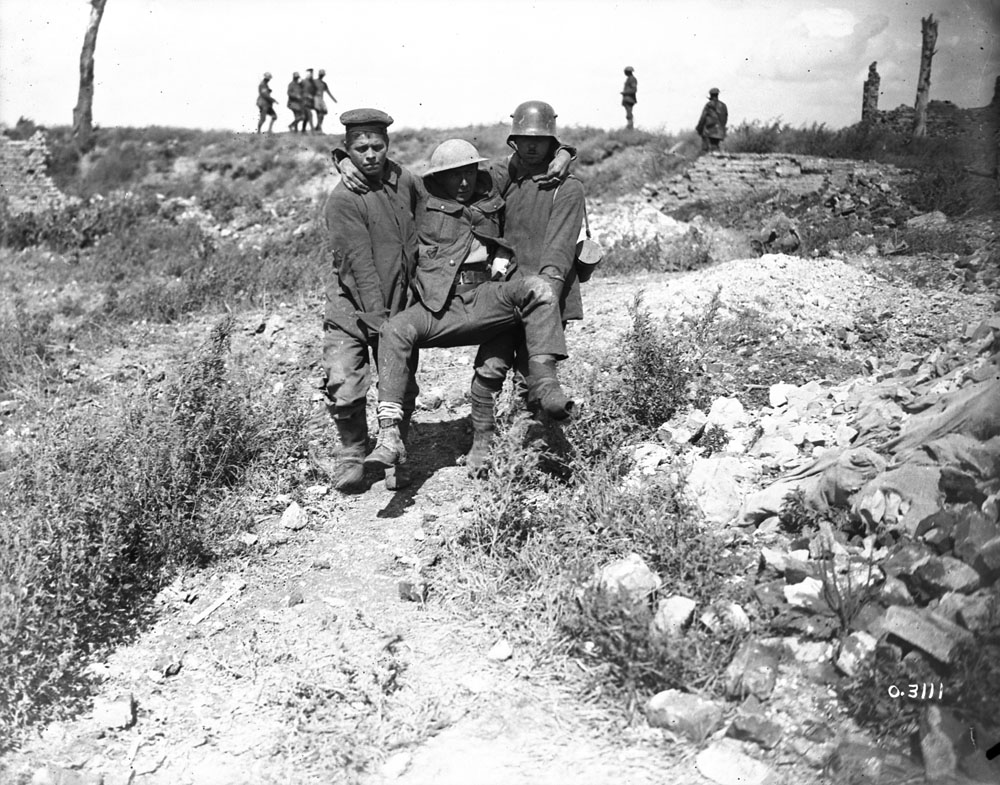Nomenclature
Battle of the Scarpe a battle honour incorporating the tactical incident Capture of Monchy-le-Preux, formally entitled the Battle of the Scarpe, 1918, and itself part of The Second Battles of Arras, 1918.

Background
Following the brilliant success of the Canadian Corps at Amiens on 8 August 1918, the Corps moved back north to rejoin First (British) Army near Arras. The Battle of Amiens the start of Canada’s Last Hundred Days.
Shock Troops
As elite Shock Troops, the Canadian Corps consistently at the Tip of the Sword during this decisive period. Only soldiers of the German Alpenkorps, considered to be the best by the Allies, able to temporarily halt the advance at Hallu on 12 August 1918.

Hindenburg Line
Later, in mid-August, plans laid for First Army to attack east toward the German-held Drocourt-Quéant Line, an extension of the Hindenburg Line. The 2nd (Major-General Sir H.E. Burstall) and 3rd (Major-General L.J. Lipsett) Canadian Divisions began the advance on 26 August attacking on a four-mile frontage between the village of Neuville-Vitasse and the River Scarpe. The Canadians quickly captured the villages of Monchy-le-Preux and Guémappe.

Byng Boys
The 51st British Division under Sir Julian Byng formed part of the Canadian Corps and provided flank protection north of the Cambrai Road. According to Currie’s plan, simultaneous attacks launched by the British Division on the left, the 3rd Canadian Division between the Scarpe and the Cambrai Road, and finally the 2nd Division on the right.

Byng of Vimy, formerly the commander of the Canadian Corps, the reason men still referred to themselves as Byng Boys. General Sir Julian Byng, more than happy to help his close friend, former subordinate, and protégée.

Battle of the Scarpe H-hour: August 26, 3:00 a.m.
No less than 14 field artillery brigades and nine heavy artillery brigades opened the barrage. In addition to the artillery of the 2nd and 3rd Canadian Divisions already engaged in the offensive, these units included the artillery of the 15th, 16th and 39th British Divisions and three army brigades.

The attack made good progress. The 3rd Division captured Monchy, the first objective, with a skilfully executed encircling manoeuvre, praised long after the tactical feat.
Monchy-le-Preux

Guémappe
On the right, the 2nd Division captured the villages of Guemappe and Wancourt during the afternoon. By nightfall, the Canadian line extended about 914 metres east of Monchy.

Battle of the Scarpe 27th August
Orders for the 27th to break through the Fresnes-Rouvroy Line and thereby advance by eight kilometres. It took two more days of bitter fighting before this defence system near Boiry-Notre-Dame penetrated, and when the Battle of the Scarpe ended on August 30, resolute German garrisons still stubbornly clinging to it.

Nothing more dangerous than a retreating enemy, as the Canadian casualties proved.

Two phases of the Arras operation cost the Canadians nearly 11,000 men. During the Battle of the Scarpe Georges Vanier, the future Governor General of Canada, lost his leg while commanding the 22nd Battalion.

Amongst the thousands of soldiers wounded in this battle a Montreal car washer of Japanese origin, Ischimatsu Shintani, an infantryman with the 24th Battalion who suffered serious head injuries.
Victoria Cross
During the first stage of the battle, Lt Charles Smith Rutherford of the 5th Canadian Mounted Rifles earned the Victoria Cross. While commanding an assault party, Rutherford suddenly found himself ahead of his men and near a fully-armed enemy party outside a pillbox. Alone, he persuaded the Germans they were surrounded and, believing that this was actually true, they surrendered.

Forty-five Germans, including two officers and three machine-gunners surrendered to Robertson. After they surrendered, Rutherford noticed another pillbox holding up the assault of his troops. He attacked and captured another 35 Germans.

Rutherford survived the war and served as the Sergeant of Arms in the Ontario Legislature from 1934 to 1940, and he would be the first Sgt Of Arms to eject a member from the legislature. Also the last recipient of the Victoria Cross from the Great War to die, when he passed away on 11 June 1989 at the age of 97.
Battle of the Scarpe Aftermath
The Germans subsequently withdrew into the prepared positions of the Drocourt-Quéant Line and the Canadians continued their advance with plans to attack the Drocourt-Quéant Line on 30 August 1918.

Battle of the Drocourt-Quéant Line
The victory at the D-Q Line, though unexpected, another mark for the Canadian Corps very successful Hundred Days. Sir Arthur Currie believed the fighting during the Arras battles to be the most difficult the Corps had ever faced; however, the pace would not be slowed.
Canadian losses for the D-Q Line fighting 5,622 killed or wounded on 2 September alone.
More
Please Subscribe
Please subscribe to CEFRG to be notified by email when there are new posts. Subscription is free, and your email kept confidential.
